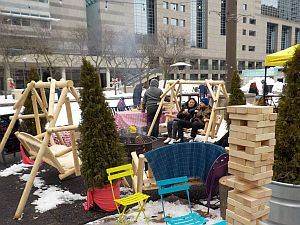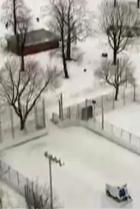
Centre For Local Research into Public Space (CELOS)
Rink Social: 2019

Mel Lastman rink, March 3, 2019 "Rink Social" pilot
Rink Social Final Report Almost no city staff who we asked about this 2019 "place-making pilot" seemed to even remember it -- we finally had to get it through Freedom of Information
These documents also came through FOI:
Evergreen invoice to Parks and Rec: $110,739.96
City media announcement Launching the first of four "place-making pilots....The Rink Social pilot will be delivered in partnership with the Maple Leaf Sports and Entertainment Foundation and Canadian Tire Jumpstart Charities."
But this project seems to have been more on the basis of a handshake than any signed agreement, or at least we never got a copy.
Conclusions of the final report for City of Toronto Parks, Forestry, & Recreation
Prepared by Evergreen and La Pépinière
summary of insights (p.20) -- code for "what didn't work"
capacity building: Adequate lead time and earlier site selection would have enabled greater participation and more applied learning for participants.
planning: Site selection is both a key process in and of itself and in placemaking work has such a high impact on all aspects of the planning process that the earlier it can happen, the better.
site selection: A cooperative mentality amongst site staff/leadership and motivation to participate in a pilot project are likely more important criteria for choosing a site than any perceived physical limitations.
site programming: Activities need to be evaluated based on their contribution to the suite of offerings, not solely on their own merit. A good number and variety is key.
site design & furnishings: Natural elements mixed with site furniture with warm colours and textures got a strong positive response from the public. Tweaking layout to concentrate activity and adapt to site patterns and sightlines is key.
food & drink: Not as easy as it seems. Cultivating relationships with suppliers and building a regular audience for them is key to success for this key component of this placemaking project
communications: Leveraging local partnerships and adequate lead time for promotion are critical to build participation
public response: The public is hungry for enhanced experiences with their families that are both active and social at City rinks and are deeply appreciative of them
recommendations (p.22)
1. create new routines: Take steps towards enabling Rink Social to stay longer at chosen sites to build audience and routines with the public and City staff – 1 month to season long residencies at given site
2. experiment with scale: Refine staffing requirements and material/storage needs so that Rink Social components can be scaled at a given site throughout the rink season (ie. More furniture out on weekends, fire one day a week, sledge one day a month, etc.)
3. invest in internal leadership: Build City staff capacity by considering assembling a small placemaking group that could play a leadership role internally and support the refining of routines, designs, materials and programs
4. maximize value year round: Map out current and potential placemaking locations throughout the year to better understand which materials and programs could be repurposed to other seasons and locations
5. build on the momentum: Rink Social was so well received by the public and was catalytic in extending the public’s outdoor, active and social time in winter. Adjust the offering for next winter while building on the success of the first pilot
These insights and recommendations were completely unfamiliar to Rec management when we met with them over some months in 2024. And the overlap between the Dufferin/ Wallace/Campbell rinks experience and this "pilot project" had no resonance.
So there was no follow-up to the recommendations.



 Show search options
Show search options





 You are on the [Rink Social] page of folder [Background Research]
You are on the [Rink Social] page of folder [Background Research] For the cover page of this folder go to the
For the cover page of this folder go to the